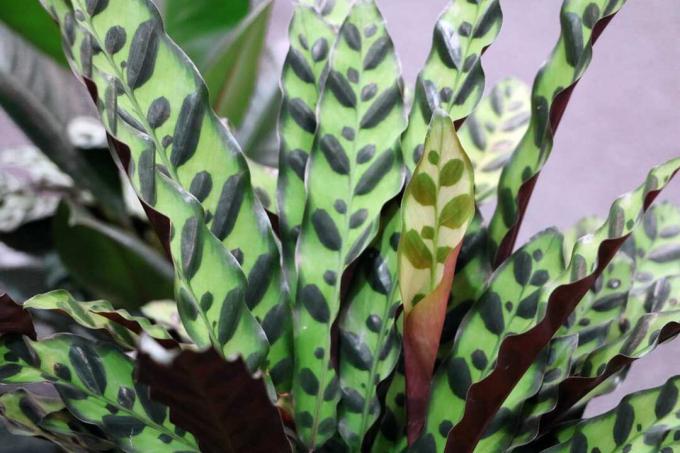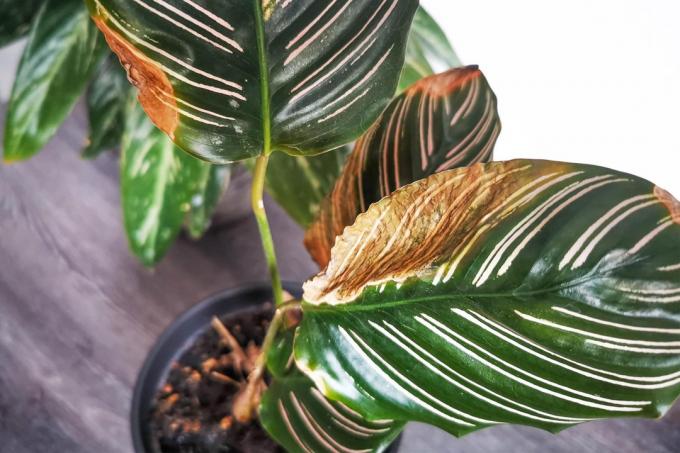

Table of contents
- Location
- substrate
- Pour
- Fertilize
- Cut
- bring to bloom
- repot
- multiply
- division
- cuttings
- leaf care
- Editor's conclusion
- Worth knowing about Calathea rufibarba and makoyana shortly
Are you struggling with a corner of the living room that is basically too shady for plants? Then the basket marante is an excellent solution. The tropical foliage plant scores with a nonchalant attitude towards poor lighting conditions, as long as it is only warm enough at the location.
Among the multi-faceted varieties, there are in particular the plain-colored Calathea rufibarba and the apart drawn Calathea makoyana, which is just as undemanding in all other aspects of care give. Read here what is important in their cultivation.
Location
The calm attitude towards the lighting conditions at the location qualifies the basket marante as an extremely versatile houseplant. As the following expectations of the light and temperature conditions show, the function of the arrowroot plant is by no means limited to solving problems:
- semi-shady to shady position
- in a sunny place shaded by curtains or a featured plant
- warm with temperatures not below 18 °C
- no risk of cold drafts
A high level of humidity of more than 70 percent plays a central role in the professional care of Calathea rufibarba and makoyana. Unless they are cultivated in a greenhouse, appropriate precautions should be taken in their immediate vicinity. An air humidifier creates a tropical climate, as does a babbling indoor fountain. Alternatively, fill the coaster with pebbles and water. During evaporation, the plant is permanently surrounded by humidified air.
Tip:
If the temperature level constantly exceeds the 25-degree mark, the basket marante is sprayed with low-lime water every day.
substrate
Since the green plants depend on a certain level of nutrients, high-quality compost-based potting soil should preferably be used as a substrate. You can mix it yourself by combining 3 parts compost or leaf soil with 1 part peat or peat substitute. To create good permeability, add a handful of perlite or expanded clay. A slightly acidic pH value of 4.5 to 5.5 has an advantageous effect on the growth of the tropical beauty.
Pour
Due to its genetic makeup, the Korbmarante knows two seasons: the muggy, warm rainy season and the cool dry season. The better these tropical climate conditions are simulated, the more at home Calathea rufibarba and makoyana will feel in your living room. Therefore, design the water supply in this rhythm:
- Keep the substrate constantly moist from April to October.
- As soon as the soil dries, it is poured with low-lime water.
- If the coaster is not filled with pebbles, it will be emptied after 20 minutes.
- Reduce the watering quantity slightly from November to March.
- The root ball must not dry out at any time.
The ornamental plant interprets the throttling of the water supply as the beginning of the cool dry season, so that it adjusts to the winter conditions with lower temperatures at the same time. The minimum of 18 °C must not be fallen below, in order not to attract the displeasure of the exotic roommates.
Fertilize
An uninterrupted supply of nutrients is required to produce the magnificent foliage. This care aspect also takes into account the differing requirements between the summer growth phase and the winter dry dormancy.
- Apply liquid fertilizer every 14 days from April to October
- from November to March extend the rhythm to every 4-6 weeks
- in the year after acquisition or repotting is not fertilized
The fertilizer preparation must not be applied to dried substrate. If in doubt, pour a little with clear water beforehand.
Cut
The Korbmarante accepts a pruning at any time. Simply cut out withered leaves with scissors. The same applies to withered flowers. A cut in early spring causes the least stress, just before the new shoots.
bring to bloom
A targeted impulse is required to encourage the tropical plant to flower. Do not count on the first flowering after purchase, as this results from a short-day imitation at the hands of the professional gardener. To keep the pretty buds popping out regularly for years to come, follow these steps:
- from mid-August put the calathea under a dark hood from 6 p.m. to 8 a.m
- Repeat this process daily for 4-6 weeks
In combination with the reduction in irrigation water, you convince the Korbmarante of the beginning of the dry season, which is accompanied by a beautiful bloom.
repot
If the root ball no longer finds enough space in the bucket, the care protocol is expanded in the spring to include repotting. The new planter is a maximum of 5 cm larger in circumference and has an opening in the bottom for water drainage.
- a drainage of grit or broken pottery over the bottom hole effectively prevents waterlogging
- Fill in a layer of substrate and press down lightly
- repot the basket marante to shake off the used soil
- Insert in the middle, fill in the cavities and cast on
- a pouring edge of 2 to 3 cm makes sense
Experienced hobby gardeners take this opportunity to take a close look at the root ball. Rotten, obviously troublesome roots are cut out and tangles pulled apart with both hands.

multiply
You can handle the offspring of Calathea rufibarba and makoyana in two different ways. It is completely uncomplicated by division. The cuttings method requires a little more effort.
division
This form of propagation is also used for effective rejuvenation. During the main vegetation period, pot the plant. With a sharp, disinfected knife, cut the root ball into several parts. Each segment should have 2-3 shoots. Without long delay, plant the pieces in individual pots to care for them like an adult specimen from the start.
cuttings
If you can't bring yourself to attack your ornamental leaf plant with a knife, you can use top cuttings. Healthy, vital leaves with at least two leaves come into question. They are cut just below a bud to a length of 10-15 centimeters.
- Cultivation pots fill with nutrient-poor substrate
- Insert half of each cutting and water
- spend in a mini-greenhouse in a semi-shady place
At temperatures of 22-24 °C, rooting takes about 4 weeks. During this time, keep your pets constantly moist and air them regularly. After the roots have formed, the temperature can be reduced to 18-20 °C.
leaf care
If you follow the instructions in these care instructions, the basket marante will present itself in a lush dress of leaves. Due to their size, they act not only as eye-catchers, but also as dust catchers. You can effectively counteract this shortcoming with the following simple means:
- Wipe dusty leaves with a damp cloth
- A little algae juice on the underside and top of the leaves gives additional shine
- alternatively rub the leaves with the inside of a banana peel
Taking a shower is less recommended. The tropical plant is so sensitive that it hardly survives the shock.
Editor's conclusion
The hobby gardener is quick to appreciate the elegant wicker plant, and it only needs a few cares to be cared for. If it never gets cooler than 18 °C at the location, it can also be in the shade. If the humidity then fluctuates around a value of 70 percent, the prospects are good for a successful cultivation of Calathea rufibarba and makoyana. The leaf ornamental plant feels particularly at home when the water and nutrient supply simulates the tropical rainy and dry season.
Worth knowing about Calathea rufibarba and makoyana shortly
General care instructions
- While these two species differ somewhat in care, origin, and requirements, they also share clear similarities.
- The C. rufibarba is native to the tropical rainforests of South Africa where C. makoyana is at home in Brazil.
- The leaves of Calathea rufibarba are narrow and long while Calathea makoyana has rather rounded leaves.
- Both species need relatively high humidity for their growth, which must be constant at values between 60-80%.
- A room temperature of 20-25 °C is a must, especially in summer. In winter, the temperatures are allowed to max. 18°C drop.
- A bright to semi-shady place is recommended as a location, direct sunlight should be avoided.
- Both species like it slightly damp. You should therefore make sure that the root balls do not dry out. Water moderately!
- It is advisable to use rainwater for watering. Tap water should be boiled or at least left to stand overnight.
- Young plants are repotted annually in spring, older plants every 2-3 years, depending on growth strength.
- So-called pot bowls are ideal as planters, because the roots of the two Calathea species grow more broadly than deep.
- Reproduction is the same for both species. By dividing the canes when repotting.
Substrate & flowering
- While the Calathea rufibarba gets by with permeable standard soil, the Calathea makoyana needs slightly acidic soil.
- This is achieved by mixing peat with some coniferous or leaf soil.
- Calathea rufibarba produces pretty, yellow flowers that grow straight out of the ground.
- In order to achieve flowering, the plants receive a maximum of 10 hours of light per day in autumn.
- Too much light can be avoided by covering the plant with a cardboard box.
- A lack of it should be compensated with special growth lamps.
Location & fertilization
- The nutrient requirements of both plants are within the normal range.
- In their growth phase, the plants receive a 0.1% fertilizer dose every 14 days.
- Dry air and soil are tolerated just as little as waterlogging.
- With optimal care, pest infestation is not to be expected. However, air that is too dry causes an infestation by spider mites.
- The Calathea makoyana is a typical warm house plant. You won't have much luck with her in the living room.
- Calathea rufibarba also thrives on a removed flower window - preferably not directly on the cold window sill.
- A styrofoam plate softens the cold that emanates from marble window sills.
- A location on a wooden pedestal near a window is even better.
 garden editorial
garden editorial I write about everything that interests me in my garden.
Learn more about houseplants

16 cat-friendly houseplants
If you share an apartment with a cat, you should not have any poisonous indoor plants, because cats occasionally eat the greenery. There are many cat-friendly houseplants that are harmless and can recover quickly once a cat has bitten them.

Calathea gets brown leaves: how to save?
The foliage of a calathea, also known as a basket marante, has its price. And that doesn't mean the purchase price. The tropical plant wants to be cared for and feels like it is in its native rainforest. She expresses her dissatisfaction with unfavorable living conditions with brown leaves.

Monstera droops leaves: what to do?
Its serrated leaves make the Monstera one of the most popular indoor plants. But what can be the reason for it letting the leaves droop, and what can you do about it?

Water houseplants properly 15 tips for potted plants
Watering indoor plants properly sometimes turns out to be more difficult than expected. There are certain points you need to keep in mind when watering your indoor plants so they can show off their full glory. 15 tips on the subject can be found in this guide.

Efeutute, Epipremnum aureum: care from A - Z
The ivy or Epipremnum aureum is one of the most popular houseplants par excellence and is also ideal for people without a green thumb. You can find out how to care for the plant from A - Z here.

Christmas Cactus Losing Buds: 6 Reasons & Solutions
The Christmas cactus is a real feast for the eyes in the living room from late summer with its beautiful flowers. Unfortunately, it often happens that the houseplant loses its buds. Find out here what causes the buds to fall and how you can counteract them.
